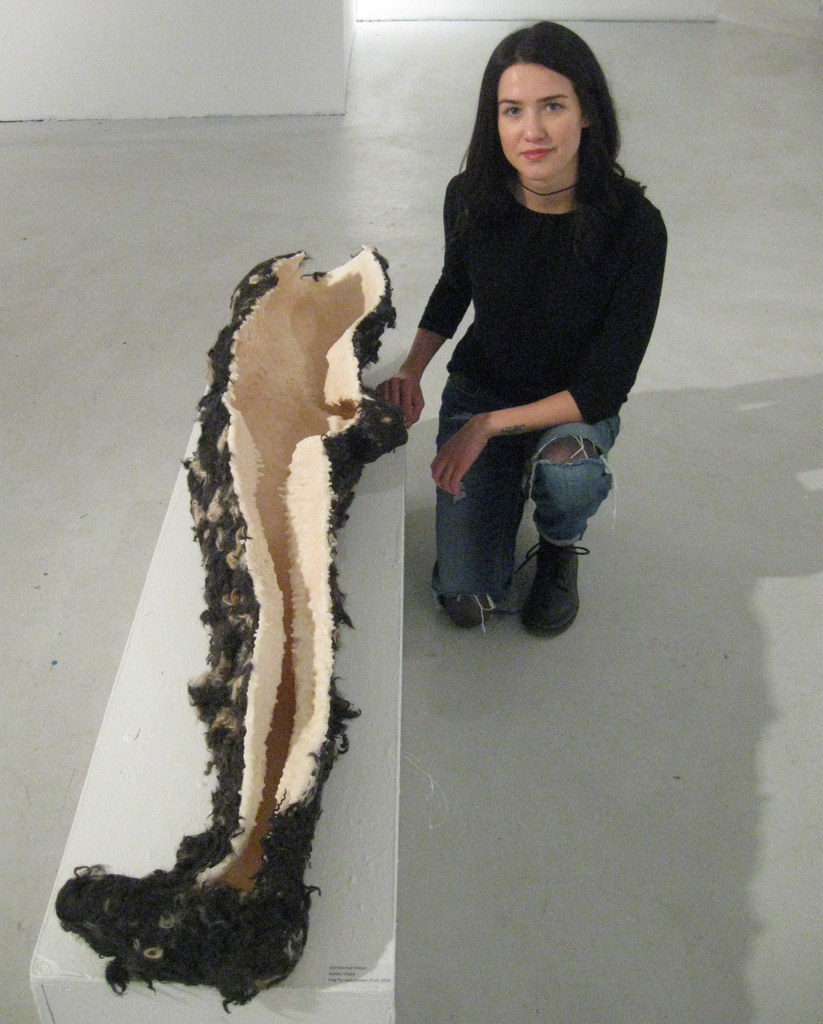 Ashley Snook with (Intra)terior Vessel at ECO ART 2017, Gallery 1313. Photo: Phil Anderson
Ashley Snook with (Intra)terior Vessel at ECO ART 2017, Gallery 1313. Photo: Phil Anderson
Interview With Ashley Snook (AS) by Phil Anderson (PA)
Ashley Snook is a young emerging artist, a graduate of the Interdisplinary Masters In Art , Media and Design ( IAMD) Program at OCAD University. She is from the North Bay area in Ontario and did her BFA at Nipissing University. Currently she is exhibiting as part of the ECO ART 2017 at Gallery 1313, where I met her.
PA: How would you describe your art practice?
AS: I describe my art practice as studio-based in where I predominantly work in sculpture and drawing. My art practice speaks to ideas that surround human and nonhuman species—within my practice, I like to experiment with organic and synthetic material.
PA: What were the influences that shaped your current body of work?
AS: A few concepts I address in my work act as influence. One, is intraspeciation which is a term I use to position myself as an artist who embraces an embedded animality and the connections amongst species. Two, is the notion of biophilia—a term used by Edward O. Wilson which speaks to innate curiosity of other living organisms (animals, plants, etc.). On a more personal note, it is where I grew up and the experiences I endured in Northern Ontario that drive aspects of my practice.
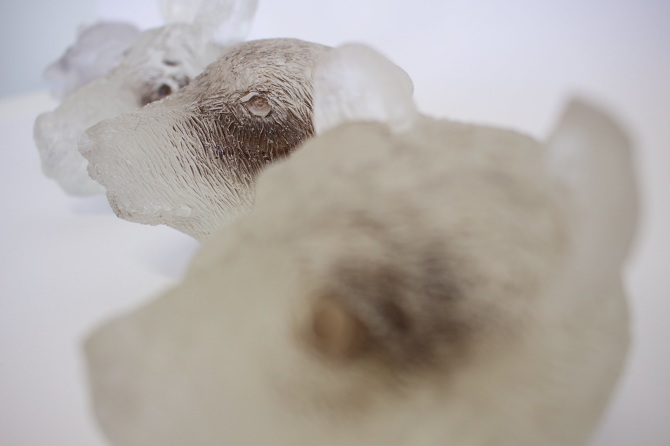 Ashley Snook, Interspecies Memoir, 2016, polyester resin, hair. Courtesy of the artist
Ashley Snook, Interspecies Memoir, 2016, polyester resin, hair. Courtesy of the artist
PA: Why do think it is important to acknowledge oneself’s animality?
AS: I believe it is important to acknowledge one’s animality because—we, as humans, are animal. I propose a lost of affinity between human and animal and argue that we cannot survive as a species without the existence of other species (nonhuman). Like the environmental issues raised in ECO ART, it is important to take note of these radical misconceptions, and move past an anthropocentric viewpoint.
PA: How has your art work evolved over the years since you started on your BFA?
AS: My work, even in my undergrad, has always involved animals…I would say from the second year of my undergraduate experience, I was creating these humorous human/animal hybrids or incorporating animals in some way, whether that was through printmaking, drawing, painting or sculpture. It wasn’t until my last year of my undergrad where I wanted to address more political concerns regarding “the animal”. I found an extreme interest in sculpture in my forth year of my undergrad, which I really wanted to pursue with further academic study. On into my Master’s, I used my own curiosity of nonhuman species, and the notion of animality to shape my work.
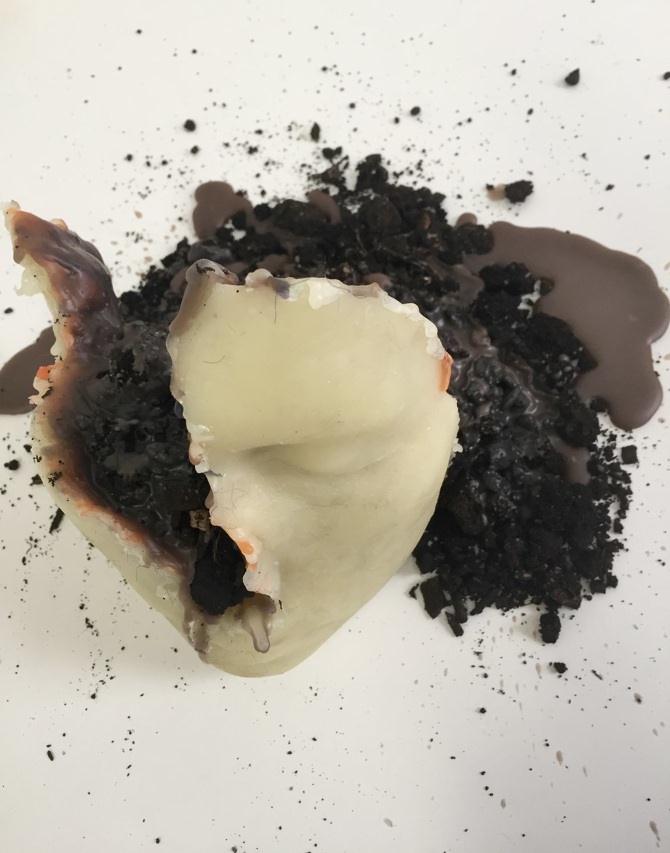 Ashley Snook, Cerebral Soil, 2015, Wax, dog fur, soil, pigment. Courtesy of the artist
Ashley Snook, Cerebral Soil, 2015, Wax, dog fur, soil, pigment. Courtesy of the artist
PA: One of your current works on view at Gallery 1313 uses dog fur on a body casting of your leg and torso. Can you describe why you used these materials and its significance?
AS: (Intra)terior Vessel seeks to explore the disorientation of selfhood. By exploring the interior and exterior of my body, animality is brought to the surface by the incorporation of dog fur and manipulation of human form. By rendering my body ambiguous, the shape has been noted to look like a fish or whale. I use dog fur as a medium. Removed from content, using the fur as a material has come to represent animality. I use wax within the interior to form drips within the tunnels of the form. I believe the wax I used gives the notion of fat, or flesh, which brings tactility to the work.
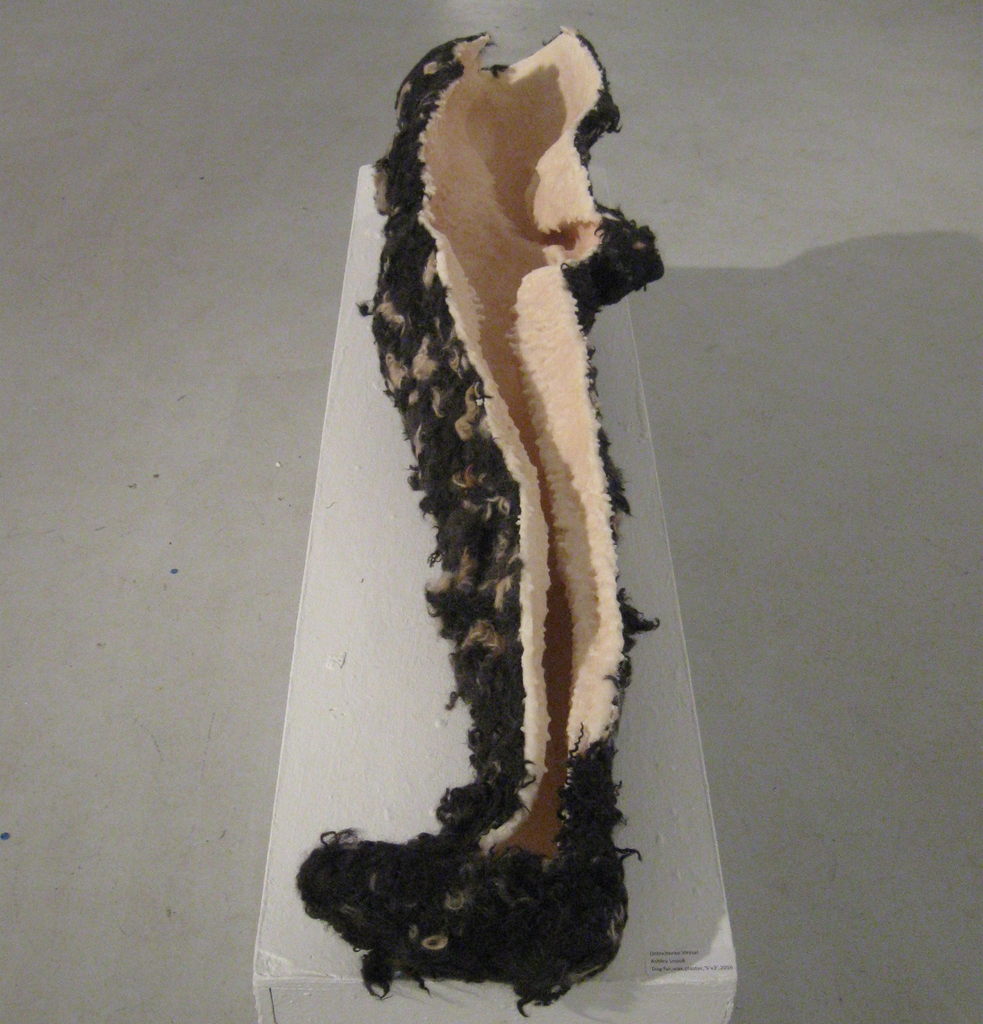 Ashley Snook, (Intra)terior Vessel, 2016, wax, dog fur and vessel. Photo: Phil Anderson
Ashley Snook, (Intra)terior Vessel, 2016, wax, dog fur and vessel. Photo: Phil Anderson
PA: You also use drawing as another side of your art practice. What role does drawing play in your work?
AS: I typically go back and forth from drawing to sculpture. When I return to drawing, I use it almost as a therapeutic tool—I have a higher level of concentration, or rather, I think more when I’m drawing because I am focusing on one thing at a time.
PA: You use some yoga poses in the drawing Hydrid. What prompted that choice?
AS: I’ve used a particular yoga pose in Hybrid (In)Synced to play with the connective aspect the two figures share. I’ve used yoga poses in previous drawings as I believe I subconsciously relate it to how drawing is a therapeutic/meditative tool for me. I also feel similarly about practicing yoga. I also find a lot of yoga poses use reference to nonhuman species (eagle, frog, cobra, tree, etc.)—I find this influential and relative to aspects of my work and the themes I address.
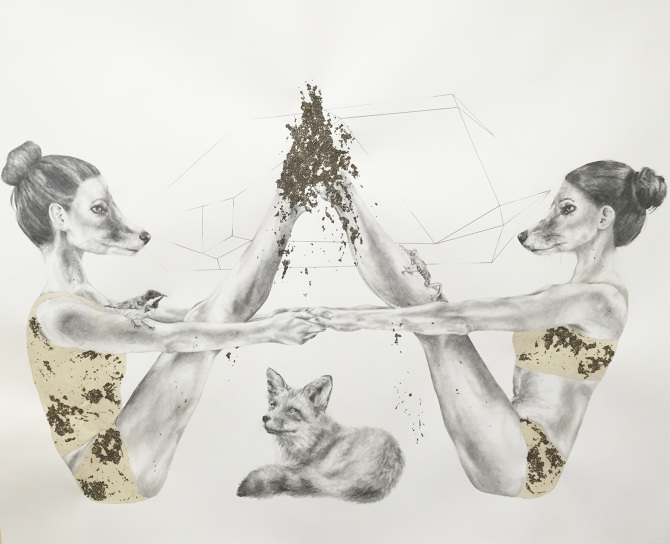 Ashley Snook, Hybrid-Insynced, 2016, drawing with chia seeds and seed paper, 3′ x 4′. Courtesy of the artist
Ashley Snook, Hybrid-Insynced, 2016, drawing with chia seeds and seed paper, 3′ x 4′. Courtesy of the artist
PA: Chia seeds are attached to this drawing. Do you use these materials with other drawings as well and how does it play a part of your work?
AS: This is currently the only drawing I’ve used chia seeds for as a medium and refer to the state of transformation. I have used chia seeds in the past for sculptural works in where I actually let the seeds grow and transform my work.
PA: Talking about your roots you said than being surrounded by wilderness and animals shaped your work. Does the urban environment and your time spent here shape your work also?
AS: The urban environment doesn’t directly influence my work, although, it makes me long for nature—the nature that I am used to back home. I think the urban environment makes me think about how we continue to expand our concrete jungle and yet implement our own version of nature/biosphere.
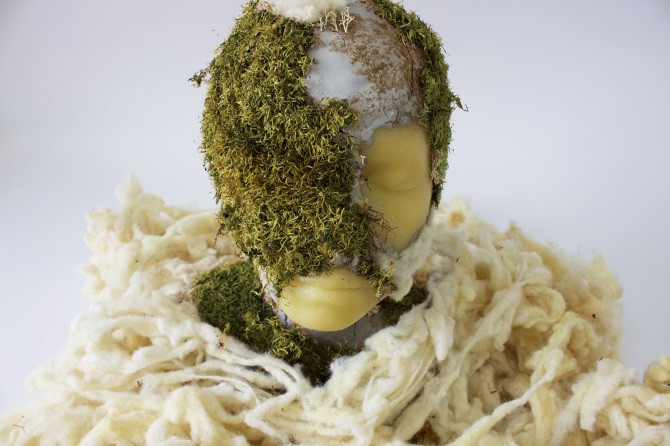 Ashley Snook, Becoming, 2014, Moss, clay, sheep wool, wax. Courtesy of the artist
Ashley Snook, Becoming, 2014, Moss, clay, sheep wool, wax. Courtesy of the artist
PA: Your thesis project was done at Allan Gardens. How did your work stand out in such a setting? Are you likely to look for alternative venues to present your work in the future?
AS: Using Allan Gardens Conservatory as a space to exhibit my thesis work, I believe, complimented it in such a way that it heightened the concepts that I was addressing and almost felt as though my work belonged there. I am interested in how space corresponds, and works with certain artwork. I would like to continue working with alternative spaces but also appreciate showing my work in a gallery setting.
PA: What are you currently working on?
AS: Currently I am working on some textile work, a project that involves plant growth and embroidery and seeing where that takes me.
*Exhibition information: ECO ART 2017, Gallery 1313, 1313 Queen Street West, Toronto. Gallery hours: Wed – Sun:1 – 6 pm.
